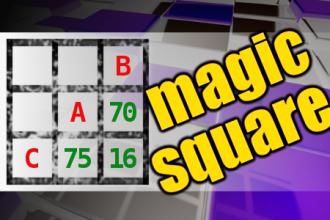MAGIC SQUARE: Calculate A*B-C
The aim is to place the some numbers from the list (5, 6, 11, 16, 17, 22, 34, 69, 70, 75) into the empty squares and squares marked with A, B an C. Sum of each row and column should be equal. All the numbers of the magic square must be different. Find values for A, B, and C. Solution is A*B-C.
Smart dog and the butcher
A butcher in his shop, and he's real busy, and he notices a dog in the shop. He shoos him away. But later, he notices the dog is back again.
So he goes over to the dog, and notices he has a note in his mouth. He takes the note and it reads, "I need 12 sausages and a leg of lamb, please. The dog has money in his mouth, as well." The butcher looks inside and, lo and behold, he finds the money for the order there. So he takes the money, and puts the sausages and lamb in a bag, placing it in the dog's mouth.
The butcher is well impressed, and since it's close to closing time, he decides to shut up shop and follow the dog.
So off he goes. The dog is walking down the street, when he comes to an intersection. The dog puts down the bag, jumps up and presses the button for the walk signal. Then he waits patiently, bag in mouth, for the lights to turn. They do, and he walks across the road, with the butcher following him all the way.
The dog then comes to a bus stop, and starts looking at the timetable. The butcher is in awe at this stage. The dog checks out the times, and then sits on one of the seats provided. Along comes a bus. The dog walks around the front, looks at the number, and goes back to his seat. Another bus comes, again the dog goes and looks at the number, notices it's the right bus, and climbs on.
The butcher, by now open-mouthed, follows him onto the bus.
The bus travels through the town and out into the suburbs, the dog looking at the scenery. Eventually he gets up, and moves to the front of the bus. He stands on 2 back paws and pushes the button to stop the bus. Then he gets off, his groceries still in his mouth.
Well, dog and butcher are walking along the road, and then the dog turns into house. He walks up the path, and drops the groceries on the step. Then he walks back down the path, takes a big run, and throws himself -Whap!- against the door. He goes back down the path, runs up to the door and -Whap!- throws himself against it again.
There's no answer at the house, so the dog goes back down the path, jumps up on a narrow wall, and walks along the perimeter of the garden. He gets to an open window, barks several times, walks back, jumps off, and waits at the door.
The butcher watches as a big guy opens the door, and starts laying into the dog, yelling at him and swearing at him.
The butcher runs up and stops the guy. "What the world are you doing ? The dog is a genius. He could be on TV, for heavens sake!"
To which the guy responds, "Clever, my ass! This is the second time this week that he's forgotton his key."

